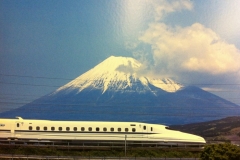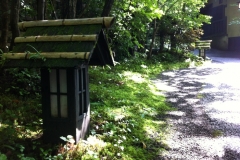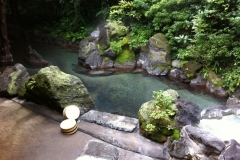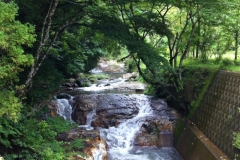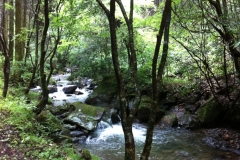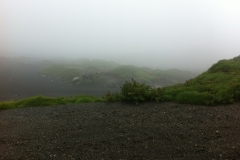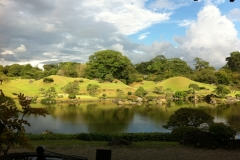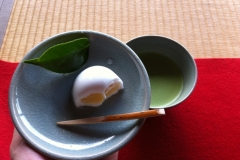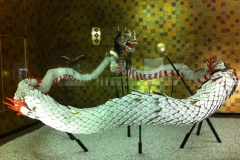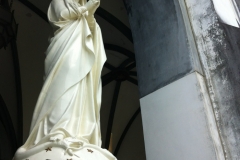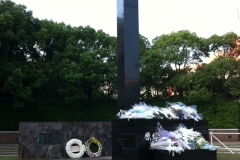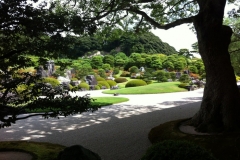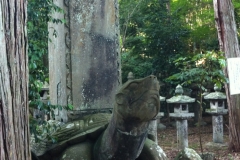Day 14 / travel time
Waking up, putting on the simple green ryokan yukata and it’s red, broad, silklike obi, having a bath in the morning sunlight, listening to the sound of wind in the leaves and the gurgle of the rill and watching spider webs sparkling in sunlight with a beautiful contrast to shadows around me. Than another delicious breakfast and time to pack calmly.
Taking our time was definately worth it, even though it ment arriving very late in Kyōto after a long, annoying journey.
Day 13 / Kurokawa Onsen
We went to Kurokawa to relax and on this day we did exactly that. After another delicious meal for breakfast we spend time in the ryokan. I checked the women’s indoor bath were I relaxed and had a nice chitchat with a cleaning woman. Still my Japanese is sooo small, but at least I can manage some real conversation, being able to reply to all this kindness in Japan. I also read some chapters in a book about tea ceremony I bought in the beginning of the semester, but never found the time to read until now. What a beautiful moment, sitting there in this stylish room, listening to the sound of the waterfall nearby and reading about so many interesting Cha-no-kai details.
We walked back to the village and leisurely visited two onsen there and another private one when we returned to Sanga Ryokan – the nicest I’ve ever been in. A round rotemburo in a wide wooden bathtub with amazing smell and a view on the other side of the mountain with greener than green marple trees. Sooo calm… and simply perfect.
Did I said, we had more than a lot for dinner the day before? This day they served even more! We could have had dinner for a hole week from what they put on the beautiful plates. It’s a miracle, that we didn’t died!
Day 12 / Kurokawa Onsen
Sometimes when you travel luck can be extraordinary helpful. In the evening before, it started raining intensively just a few minutes away from our hotel. We went under a shelter again just when a bus heading to our next destination Kurokawa stoped next to us. If we didn’t had to wait, we would had taken another expensive taxi back to the station. But because of that, on this day we just carried our luggage a few minutes and were on our way through the mountains once again seeing the massive damage caused by the heavy raining a month ago as well as construction sites.
And than we arrived at beauuutiful Kurokawa Onsen, an oasis in the valley between supergreen mountains. The small village is mainly made of many ryokan and onsen and a perfect place to rest – without being „bothered“ by things such as combinis and internet. A driver picked us up at the bus stop and brought us to the information center and our stuff to our ryokan. We made a walk first through the mountains than the village always along these wooonderful river Kurokawa and it’s sidearms. I love the forests in the mountains and hills – both in Japan and Germany (just thinking about one near Munich and another in Lower Fraconia), but I especially love the river… the view on how the water is running through his bed over stones and woods, the greens around… the sound and smell… it was warm and humit, but the water and trees kept the temperature absolutely bearable.
After the driver brought us to our ryokan a little outside the village and after we were able to breath again – as it’s area is breathtaking beautiful – we took a bath in one of it’s onsen. It was a mixed open air bath (rotemburo) and it turned my father, who was a little sceptical before, into an onsen lover. I also checked the women only rotemburo too, which has an even nicer atmosphere directly beside the path of a small rill.
And than, yeah… for those who don’t know it – talking about ryokan is most of the times connected to getting a lot of food. Well… at Sanga Ryokan we had sooo much, you the words „a lot“ is not enough. And everything was so increadably tasty, we had to eat sooo much of it. Amazing. And the wonderful thing about Japanese cuisine is, no matter how much you eat, it’s not laying heavy in your stomach. We would have never thought about going into a bath after it, if we hadn’t reserved a private bath, which was nice, but not that amazing as the ones before. Relaxing pure and living Japanese lifestyle including wearing our Yukata we bought before for dinner. Wonderful!
Day 11 / Aso
Standing up early we headed to Mount Aso, which was an adventure for itself. Due to extreme heavy raining the area suffered from damages caused by landslips and mass of water. Part of the rail track was demaged and a replacement bus was running there. We already knew that from the internet, but an older lady was of supersweet and perfect help.
Appearently people in the area are extraordinary nice. The taxi driver who brought us to our hotel took us back to the station for free and than also stoped to get a brochure for us reporting about the heavy raining. Speaking even a little Japanese is worth sooo much in Japan!
With bus and ropeway we drove up to the Nakadake, an active vulcano with a cyan pond and sulfur smoke. When I’ve been there for the first time one could just see the smoke, so this time it was extra impressive. The area is amazing. You can walk around a little along the other, not active craters and through a lunar landscape of black sand. It’s so impressive to be so close to the earth. It’s nature and you can see how little humans can do against it’s powers. And as if nature wanted to show us a sunny picnic turned into stucking in cold clouds‘ fog before it started to rain cats and dogs. We hid under a shelter and decided not to make another walk one station below, which we than did later on the „ground“ of the plateau, where we had pure sunshine again – our sunburned skin thanked us later.
Day 10 / Kumamoto
Without any hurry we moved from Nagasaki to our stopover Kumamoto. We first took a taxi and then everything very slowly.
Our afternoon program was just to visit the Suizenji Garden, which absolutely turned any negative thoughts about this city around, where we had difficulties in the past. The garden is named after a temple, which was standing here once, but contains two shrines now. The spacious garden shows the 53 stops of the Tokaidō, the road once leading from Kyōto to Tōkyō. Most impressivly is the Fuji-san in pure intensive green grass, which is also seen from the tea house, which once stood in the Imperial Garden in Kyōto. Enjoying some matcha and sweets (mine imitated an egg and had a whipped egg whites surface and was incredably delicious) we rested and had this amazing view when the clouds opened flooding the garden in even more wonderful colors.
After some succesful yukata and geta shopping and a nice curry rice dinner we had a short time sleep in our not so nice hotel room.
Day 9 / Nagasaki
I’ve seen quite some Japanese cities and most don’t really look very different, when you don’t look at size and sightseeing or other particular places. Of cause, people are more fashionable in Tōkyō and Kyōto has more older houses and traditional shops and people wearing Kimono than others, but mainly the cities are more alike than expected. Nagasaki is different though. You can feel the touch it’s history left behind. And I don’t mean the atomic bombing, but the fact, that the city was opened to the world while others were completely closed.
Honoring this fact, we started by visiting one of the numerous churches in Nagasaki – the Oura catholic Church. A very interesting building including a quite beautiful madonna in the enterance. And a small garden with a Christ on it’s cross behind a pond, which is so typical for Japanese temples. It’s a quite strange feeling to see people kneeling down in front of this kind of pond to pray. A small museum tells about the christian history in Japan including the percecution of christians (of cause without any word saying about their missionary work).
Also the second part of our Nagasaki trip was tributed to the fact, that the city was the harbour being opened to also western countries. In the Glover Garden several western houses brought from other parts of the town are shown. It’s a quite interesting place recalling that this is part of Japanese history too. We also enjoyed to rest in the shadow of a wisteria with a sweet breakfast and a talk about plans for the future. And the museum displaying festival wagons with amaaazing figures and colors as well as beautiful dragons. I wonder of they are so typical for the city, because it had a closer connection to China too. Nagasaki also has a small Chinatown we visited before going back to our hotel in the evening.
But before that we went to the Atomic Bombing Memorial Museum. It’s smaller than the one in Hiroshima and less impressive, but it makes one angry in absolutely the same way. I’m not saying much more on this platform as this topic needs a real talk.
We didn’t went to the peace park with all the statures I’ve already seen, but to the memorial at the epicenter. I think, it’s really good as one part looks like a massive empty sarcophagus with the number of over 15.000 dead people on it – some of them pulverized to dust with nothing left but a shadow on a wall… The flowers layed down the day before, which was the anniversary of the bomb dropping, only added meaning to this feeling.
Against atomic bombs and nuclear energy for a safer world!!
Day 8 / travel time
This day was planed for traveling from humit Kyōto to humit Nagadaki and we did pretty much that. It’s been six years since I visited this special city before for the first time, but it’s amazing how short six years can feel like (not the first time I’ve got this particular feeling) and how much memories can be awaken, when coming back to a place. Strange how our brain works, isn’t it. It also remembers how special the atmosphere in a city can be, but not the bad things such as how small and poky the street cars are when you’ve got luggage.
Day 7 / Matsue, Parting and Reunion
On day number four of our tea trip three Japanese and one German girl overslept. There was no time for breakfast and in a hurry, they finished packing and joined the others, who were also dressed formal and neat. We were prepared for a special event – visiting a friend and teacher of our sensei.
We split the big group in two smaller ones. My group was the first one to drive to our famous host, who is a pottery maker and descendent of an old ceramist family. Knowing that the implements for making tea ceremony are very important one can imagine, how near to holy a traditional potter and his stunning work is to someone interested in Cha-no-kai. We were invited to matcha with delicious sweets and an appearently very nice talk I couldn’t understand a word of. Then we could see some of his art works and the huge kiln. Can you imagine, that the clay needs to rest in air for 40 years, before it’s used for making pottery? Absolutely stunning!! We also painted some simple cups, which was a nice way of producing a souvenir. Let’s see how and if mine will find it’s way to Germany.
We switched groups (I also switched into a pair of easier walking shoes) and went to the Matsue Castle, which is a relatively small, but very nice one. Before reuniting we again had some Soba and bought some Omiyage (Souvenirs) for families and friends.
Alltogether we went to one last museum, which exhibited some extraordenary pieces of pottery. Once again I experienced, that things can become intensively facinating, when you allow yourself a second look.
We spend the other half of the day traveling back to Kyoto, where I reunited with my father and to catch a good night of nearly enough sleep before leaving for our Japan tour. Resting… finally!
Day 6 / Adachi Art Museum and Matsue
We were allowed to get a little more sleep and enjoyed a delicious breakfast alltogether. Our first tourist point than was the stunning Adachi Art Museum, which not only shows some amazing pieces of Japanese art, but also has presents a couple of Japanese gardens of absolutely superb quality. Everything very high-class and deeply inspiaring!
I cannot imagine, that anyone of us could have been hungry at that point, but we drove to a restaurant of a Ryokan, where we had a massive lunch. It was really delicious, but I still felt a little bit like being fatted. Speciality was mixed squish on rice with broth. Another idea to try to recreate at home.
We went to two tea houses. In the first we „just“ saw the beautiful garden and the tea house itself, in the second we also had some sweets and matcha. The sweets were delicious, one with ginger flavor, the other some kind of mochi with a green sugar crust. The woman who served us the tea bowed in a different way than we learned. I was told, that they also wear their Fukusa (a cloth used for cleaning the tea utensils in front of the guest) not on the left, but the right side as the other side was reserved for the sword. It is so amazingly interesting to learn all these details. With every element added to my knowledge the wish to continue the way of tea when I’m back in Germany grows.
In a short „free time“ break of not even one hour we visited three houses and museums such as the house, where Lafcadio Hearn lived in for some time. He wrote a lot of books about Japan in the late 19th century, which were published in the western world. It was quite interesting to see how a western person lived a Japanese life around that time.
You might think, this already is enough sightseeing for one day, but nope – we went to the Gessho-ji, a temple surrounded by a beautiful, deep forest. Impressive graves of the Matsudaira family, which ruled the area, and a giant turtle stature create the feeling of visiting an important monument. The moskitos were a little… well, moskito-ish.
Only after all this program we returned to the Ryokan, had a break and then another mouthwatering, extended dinner. And sometimes it’s good to always switch of, when people around you talk in another language – they can really surprise you, such as the Musabi tea club did, when they handed me a paper board with small messages and a cute drawing of me. They were preparing that over the day and I totally had no clue. Man, so heartwarming.
It’s a bit sad, we didn’t had this trip before the end of the semester. I got to know many of the students better than before. But what a wonderful experience. And language might be a barrier, but it’s still possible to talk about politics and socials. Me like that! 🙂

